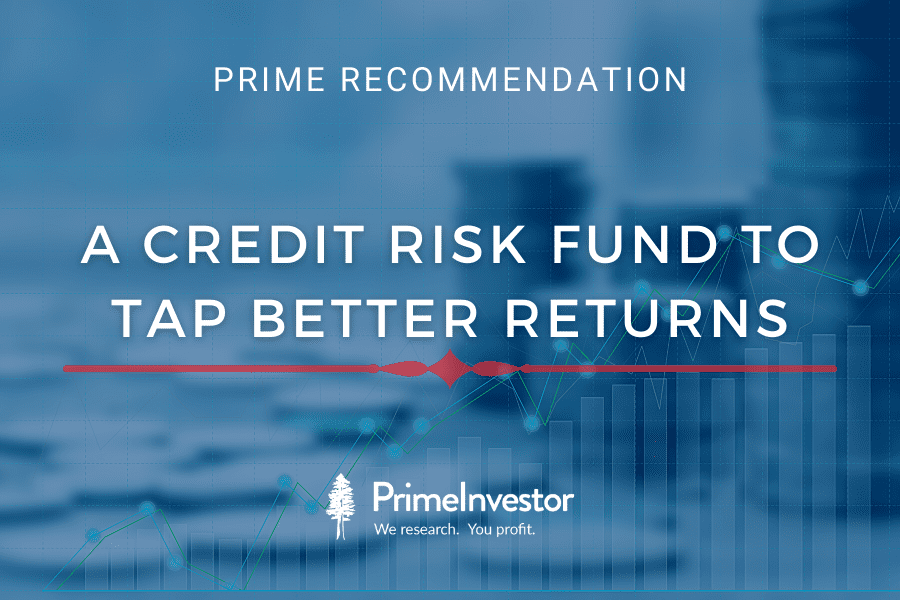In our 2022 debt outlook, we had outlined strategies you could follow to get the best out of your debt investments. Among these, we had listed opportunities in the credit space as lower-rated papers offered better spreads than top-quality ones, for those willing to take the risk. In our Prime Funds, too, we had already taken a step in the credit risk category – with this recent quarter review, we added one more credit risk fund to our recommendations.

Why credit risk funds
Up until recently, we tended to avoid funds with any level of credit risk let alone pure credit risk funds. The domino effect of the 2018 IL&FS saga on other issuers, funds themselves trying to clean up their portfolios, the risk that the lockdowns imposed on corporate credit quality and the like kept us wary of entering the space.
However, a few factors now work in favour of credit risk funds.
One, as we noted in our debt outlook, the yields in the top-quality AAA and AA+ papers have shrunk. Top-rated issuers took advantage of the preference for quality in this pandemic era and the record low interest rate scenario to borrow at low yields. As a result, the spread (or the difference) between AAA-rated or even AA+ rated papers over government securities shrunk steeply. Spreads in lower-rated papers, on the other hand, have not dropped to the same extent offering better return opportunities here. Refer to our outlook for a detailed explanation of trends in credit spreads and the opportunities in low-rated debt.
Further, markets are also starting to recognize the opportunities in the credit segment, with the heftier spreads in the papers AA and below starting to narrow. For example, between November and now, spreads in A+, A, and A- papers have dropped 27 basis points while AAA spreads stayed the same.
CRISIL’s credit upgrade-to-downgrade ratio, which measures the number of rating upgrades to the downgrades, has also steadily improved over the past 12 months. The ratio stood at 2.96 for the first half of FY-22, against the 1.33 times in the preceding half-year and 0.54 times in the first half of FY-21.
Both these factors suggest an improvement in the overall credit scenario, lending a bit more comfort in taking on credit risks now. It also may open up opportunities for funds to benefit from any rating upgrades in papers they hold. A rating upgrade results in falling yield and a price appreciation in an instrument, thus providing some capital appreciation as well.
Two, for debt funds themselves, the experience of credit impacts and write-offs over the past few years have enabled tighter regulations by SEBI and better liquidity management on part of funds. Apart from prompting funds to revise their credit review and fund structures, the events have also separated funds that have managed and handled risks well from those that were unable to keep up.
Three, while all indications are that the RBI will raise rates sometime this year and bond yields are already reflecting this, the credit space will still offer better yields. Credit risk funds, when paired along with shorter-duration and/or high-quality corporate bond funds in portfolios can therefore help overcome the low-return period of the past few years, for those willing to take the risk.
HDFC Credit Risk Fund
We added HDFC Credit Risk in our recent Prime Funds review, in the Debt – Long Term classification. The fund joins ICICI Pru Credit Risk in our credit recommendations in this timeframe.
Comparatively lower risk
In the spectrum of credit calls that a fund may take, HDFC Credit Risk tends towards the more conservative side. Over the past two years, the fund has held between 40-55% in papers rated AA and AA-. A much smaller portion goes into higher risk papers rated A and below.
Compared to its category, HDFC Credit Risk has the highest such allocation in AA/AA- papers. ICICI Pru Credit Risk, for instance, has averaged about 40% in these papers against HDFC Credit’s 43%. Others such as Nippon India Credit Risk, which sports high YTMs even now, averages about 25% in AA/AA- papers.
Controlled concentration to individual issuers
A key factor that decimated returns for several debt funds during credit events was the high exposure they had to individual issuers. In credit funds, given the already inherent risk, a dispersed holding is preferable to contain the impact of defaults, delays or write-offs. On this front, HDFC Credit manages well. The top 5 issuers now account for about 23% of its portfolio.
No issuer accounts for more than 5-6% of the portfolio; outside the top few, individual issuers typically don’t make up for more than 2-3%; it’s even lower for the higher-risk A/A- papers. Concentration has also improved from the 35% that top 5 issuers accounted for in mid-2020, when issuers such as DLF and Vedanta took up about 6-7% of the exposure. The fund has both increased the number of issuers it has invested in as well as brought down the exposure to each.
The fund is also well-placed in terms of AUM at close to Rs 9,000 crore, on par with ICICI Pru Credit Risk. The fund saw hefty redemptions post the Franklin Templeton debt fund mess in April 2020, dropping from Rs 13,812 crore in March 2020 to Rs 6,539 crore by May. However, AUMs have stabilized since then. This, the reducing concentration and that it managed the redemptions without a stark return impact all bode well from a risk management perspective.
Above-average returns
HDFC Credit has kept portfolio YTMs above the average of its category, despite its more conservative approach. ICICI Pru Credit does score over this fund in terms of portfolio yields, but that also stems from its marginally higher risk.
These better yields also translate into higher returns for HDFC Credit. The fund has put up an average 3-year return of 8.4% over the past 6-year period, just below ICICI Pru Credit Risk’s 8.9%. Other funds that haven’t seen big write-offs, such as Kotak Credit Risk, SBI Credit Risk or Axis Credit Risk have delivered lower average returns. On a 1-year rolling basis, HDFC Credit beats the category 92% of the time over the past 4 years, indicating high consistency in performance.
On the volatility front, though, HDFC Credit is more volatile; ICICI Pru Credit Risk is by far the least volatile in the credit category. However, HDFC Credit is a close second, and it does beat out other funds. The minimum returns these two funds have posted are also far better than peers. Risk-adjusted returns also score higher.
Fund suitability
While there is a better case now for credit risk funds than in earlier years, and while our recommendations involve funds that have managed credit well, it’s important to note that it still involves risk. In the debt space, defaults or downgrades can have cascading effects on funds. Therefore:
- HDFC Credit Risk suits only those investors who can take risks into stride and not be affected by impact of downgrades. It is not necessary that you need credit in your portfolio; high-quality debt funds from other categories or gilt funds will still deliver well for you.
- The fund should be used for long-term portfolios of 5 years or more only and never for short-term goals. This timeframe allows you to recover from any credit event – this gives time to let the fund recover dues or let accruals from other papers make up for the loss, or it lets you build up enough of a return cushion to absorb losses.
- HDFC Credit should not be the only debt fund in your portfolio. Debt allocation is meant to offset equity risks; using a credit fund alone will diminish this purpose, and instead add to portfolio risk. Use HDFC Credit along with corporate bond funds and/or high-quality funds from categories such as short duration, banking & PSU or medium duration. Ideally, it’s best to allocate a max of 10% to credit funds. If you already hold credit – whether through credit risk funds or through other category funds that take credit calls – avoid this fund or allocate lower.
HDFC Credit Risk is managed by Shobhit Mehrotra.







11 thoughts on “Prime recommendation: A credit risk fund to tap better returns”
hi Team,
I will be having around Rs 10000 every month after investing in Index funds and stocks. I already having ABSL Floating rate and Banking and PSU funds and Axis Liquid funds in portfolio, Can you please let me know in which fund i can invest this surplus amount every month. Can I use this hdfc credit risk fund for this purpose or can I use Gold ETF for this purpose.
thanks
Balaji
For any specific fund queries, please write to [email protected]. It’s easier and faster for us to respond there, and the blog is meant to be a general discussion forum only, and not specific to your portfolio.
Which fund to add depends on your timeframe, risk level, and other funds in your portfolio. Please use Prime Funds for our recommendations (read the Why this fund), or use the MF Review Tool to know if a fund you already have is a buy. You can invest in the credit risk fund given in this report if you’re willing to take the risk and if your timeframe & allocation is within what we have specified.
Gold is best used as a hedge against equity volatility – it may spend a long time delivering low returns before rapidly rallying to compensate. We have explained gold returns here: https://www.primeinvestor.in/what-can-you-expect-from-gold-returns-data-says/ You can read this to understand whether you want gold in your portfolio. You can even split your additional investment into debt and gold, if you wish to. – thanks, Bhavana
The yield to maturity is 6.6% and expense ratio is 1.59%, so we can expect only about 5% returns from this fund. Isnt it?
Not really, because the YTMs can go up when the rate cycle moves higher and since the fund will also change portfolios – there will be bonds that mature and fresh ones invested in. So the YTM-less-expense-ratio is not too indicative in longer-term funds. – thanks, Bhavana
Thanks. But sorry, I kind of disagree, with current yields where they are if the management fee is going to be 1.6%, it is going to be extremely difficult for this fund to outperform a 5yr Gsec passive fund with 20bps expense ratio. I mean the credit spread is pretty tight right now and what you are saying YTM can go higher, which means this fund will 1st see losses when the YTM goes higher.
I actually pulled up this fund on Valueresearch and compared its returns again 10yr Gsec over 7 year period, and the performance is the same. So all the risk that we take the reward is taken by the fund manager here. Okay granted 10yr Gsec bond yields have fallen a lot so it has benefitted from those capital gains and going forward we may not get those kind of capital gains form 10yr Gsec bond.
But from a risk reward perspective, at this time if I have to buy, I would rather buy MOSL 5yr Gsec fund. The HDFC credit risk fund may be a well managed fund, but at 1.6% TER, they are taking all the juice in it.
Thanks a lot Bhavana. Very informative, understood about MIX of AAA to A-, how spreads behaved in last few years across these categories, why it makes a good case to move down the Credit Quality for better risk adjusted returns, how risk is being managed by these funds with limited exposure to a single player and WHY it is important to stay invested for a long enough PERIOD to absorb all types of credit events. [ Trying myself to summarize what i read 🙂 ]
Just one doubt – You mentioned “Use HDFC Credit along with corporate bond funds”, what exactly it means? I checked the HOLDINGS of HDFC Credit Fund, they do have NCDs/BONDs of Corporates. Are you suggesting some other specific category or direct exposure to these bonds?
Corporate bond funds are a separate debt fund category. Funds in this category necessarily need to hold at least 80% of their portfolio in top-quality bonds. Therefore, they pair well with a high-risk debt category like credit risk funds. – thanks, Bhavana
Given the risk of rising interest rates, isn’t it better to add floater funds at this time?
Credit risk funds are less prone to rate volatility as their already elevated yields will not rise much unless their rating is downgraded. Vidya
why is your recommendation for ICICI credit risk fund whose returns in above table looks better
ICICI Pru Credit Risk is also in Prime Funds, as mentioned in the report above. Between ICICI and HDFC, the former takes a bit higher risk and delivers higher return. HDFC is a comparatively lower-risk play. – thanks, Bhavana
Comments are closed.